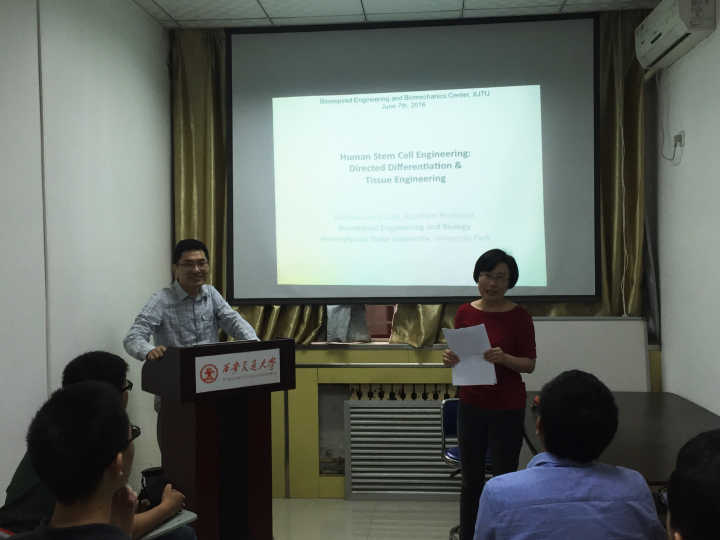On June
7th, Dr. Lian from Penn State University visited BEBC and gave a talk entitled "Human Stem Cell Engineering: Directed
Differentiation and Tissue Engineering".
Dr.
Lian is an expert for stem cell differentiation, especially to cardiomyocytes.
The following is an abstract of his speech: Human pluripotent stem cells (hPSCs) offer
tremendous promise in tissue engineering and cell-based therapies because of
their unique combination of two properties: pluripotency and virtually
unlimited proliferative potential. Hurdles facing utilization of hPSCs in
cardiovascular regenerative medicine include a lack of reliable and efficient
methods to differentiate hPSCs to cardiovascular lineages.
Here we show that differentiation
stage-specific modulation of canonical Wnt signaling is both essential and
sufficient for efficient endothelial and heart muscle cells induction from
hPSCs under chemically defined conditions. First, we report a robust method to
efficiently produce endothelial cells from hPSCs via glycogen synthase kinase 3
(Gsk3) inhibition and culture in defined media to direct hPSC differentiation
to endothelial progenitors which were multipotent, capable of differentiating
into calponin-expressing smooth muscle cells and endothelial cells. Next, we
report sequential treatment of hPSCs with Gsk3 inhibitors followed by inducible
expression of β-catenin shRNA or chemical inhibitors of Wnt signaling produced
a high yield of virtually (up to 98%) pure functional human cardiomyocytes.
Last, we report the large scale synchronization, generation, and purification
of human ventricular muscle progenitors. Using the RNA-seq and bioinformatic
analyses, we identified cell-surface markers for Isl1+ ventricular progenitors.
Furthermore, we developed a novel strategy to perform in vivo tissue
engineering using these purified Isl1+ progenitors and generated centimeter
long vascularized human ventricular tissues in murine kidneys. In addition, in
vivo intramyocardial transplantation of purified human Isl1+ ventricular
progenitors results in their spontaneous migration and assembly into
multi-cellular pure muscular patch of mature ventricular muscle cells. Our
studies suggest the clinical feasibility of generate new heart parts via
organ-on-organ level tissue engineering with large scale, purified populations
of committed heart progenitors from hPSCs.
